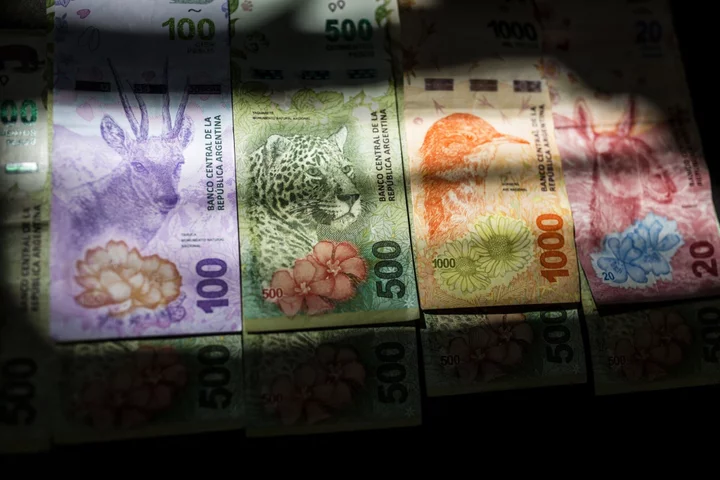Argentina’s government has created a tangle of rules about who can access dollars and for what, spawning a dozen exchange rates and making an already vexing system more complicated in a bid to delay a devaluation.
Unlike every other major economy, the South American nation doesn’t have a free-floating currency. President Alberto Fernandez’s administration restricts the peso’s daily decline through a cobweb of currency controls, price freezes and import restrictions to protect dwindling dollar reserves.
The policy hasn’t fully worked — the central bank’s international reserves have slumped to a 17-year low. At the same time, it has created an increasingly bureaucratic system where companies and consumers face high transactional costs and foreign investment has little incentive to bring dollars into the country.
Anxiety is showing in markets just days before a key primary vote that will decide who are the candidates for the Oct. 22 election. The official rate is 287 pesos per dollar while the black market trades at about 600 pesos on the streets of Buenos Aires, a record low.
Alternative exchange rates are not new to Argentina, but they’ve thrived under Fernandez, including a commonly used rate in markets and another for credit cards also trading above the official peso. The most used of these, known by Argentines as the “dollar blue,” is a free-floating, all-cash exchange rate.
Here’s a quick guide to a few of the most commonly used — and strangest — rates in Argentina:
The Official Rate
Rate: 287 pesos per dollar
Argentina’s official exchange rate is highly restricted. Individuals can only legally exchange pesos at a bank at the official rate for no more than $200 a month and must pay three taxes that add roughly 80% to the cost. Economists are forecasting a sharp devaluation of the official rate after the nation’s primary elections this weekend.
The “Blue”
Rate: about 600 per dollar
The most-commonly accessed rate among Argentines, the “dollar blue” is a free-floating, all-cash exchange rate you can get in back-rooms of stores, newspaper stands or in inconspicuous offices — or a contact willing to exchange dollars for pesos, sometimes requiring large shopping bags or backpacks to carry wads of the local notes.
The Blue Chip
Blue-chip rate: 595 per dollar
Argentina also has free-floating exchange rates for investors who buy stocks and bonds. For local transactions, an exchange rate known as “dolar MEP” is used, while the blue-chip swap rate, or “dolar CCL,” is utilized for operations that finish abroad — providing an approximation rather than a clear benchmark.
The Credit Card
Rate: 523 per dollar
Used for monthly purchases under $300, an implied exchange rate combining the official rate with the three taxes charged on credit cards for purchases in foreign currency besides pesos.
The Qatar Dollar
Rate: 598 per dollar
For monthly purchases over $300 a month, an implied exchange rate combining the official rate with the two existing taxes and new, third levy of 25%. The implied rate started when thousands of Argentines traveled to Qatar for the World Cup, to watch the national team win their third championship in December 2022.
The Coldplay Dollar
Rate: 374 per dollar
Concert promoters booking artists who charge in foreign currency will pay a 30% tax, which is passed onto the fans on top of the cost of the ticket. It’s informally named after the British rock band, which played 10 sold-out shows in Buenos Aires last year.
Malbec Dollar
Rate: 340 per dollar
The Malbec dollar, also known as the agriculture dollar or soy dollar, refers to a series of government-designed fixed exchange rate programs that have been implemented for limited periods in the last year. The program began in a bid to goad producers into selling stockpiles of soybeans, Argentina’s largest export crop, and bring greenbacks into the central bank. It currently applies to sorghum, barley and sunflower farmers, as well as wine producers.
Luxury Dollar
Rate: 575 per dollar
Well-to-do Argentines who buy luxury goods including private jets, sports cars, yachts, watches and top-shelf alcohol need to pay additional levies of nearly 100% on top of the price of the imported goods.
Tech Incentives
Tech companies can retain 30% of the dollars from additional sales abroad instead of having to exchange them into pesos, as the law stood before. The dollars are meant for employees’ salaries.
--With assistance from Patrick Gillespie.

